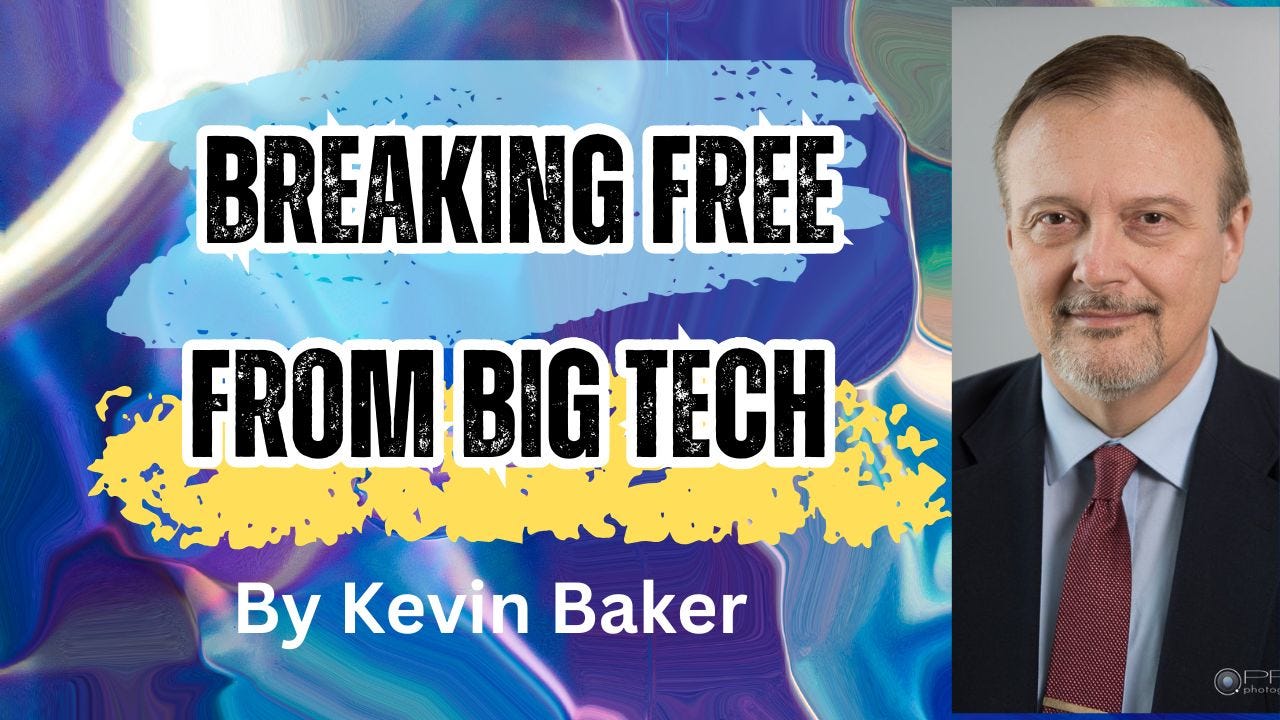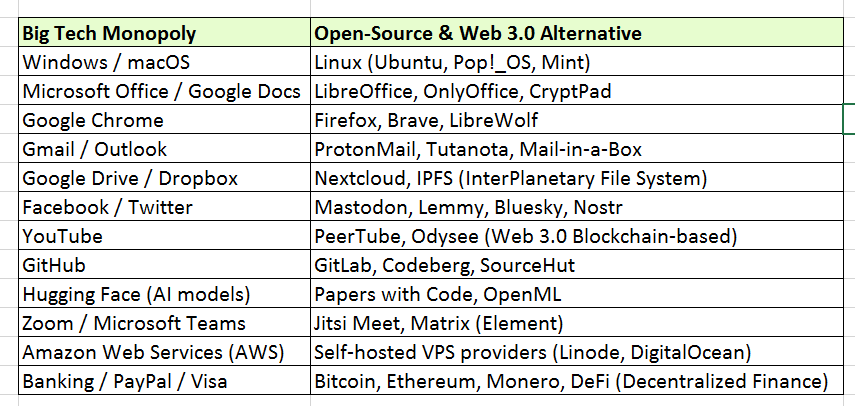Breaking Free from Big Tech
The Path to Digital Independence and Web 3.0
The digital world is increasingly controlled by a handful of technology giants—Microsoft, Apple, Google, Amazon, and Meta—who dominate markets, control ecosystems, and shape online experiences. These companies dictate what software we use, how our data is handled, and even what we see online. Their monopolistic grip limits competition, stifles innovation, and forces consumers into locked-down ecosystems.
But breaking free is possible. I was part of Web 1.0. My first email and web access was dial up on the University of Buffalo Freenet. I was there when Mosaic, Netscape, Compuserve, AOL, Prodigy, Geo Cities, Alta Vista, and so forth were forming the worldwide web. Usenet groups and the internet were free. I enjoyed the early Web 2.0 days, but knew the ethics of privacy and information were being blurred in non-disclosed monetization.
By adopting open-source software, decentralized platforms, and self-hosted solutions, individuals can regain control of their digital lives again. And beyond that, Web 3.0 promises a future where users own their data, digital identities, and financial transactions without relying on corporate middlemen.
This guide outlines the problem, the solutions, and a step-by-step roadmap for transitioning from a novice to an expert in tech freedom and Web 3.0.
The Problem: How Big Tech Controls the Digital World
The major tech companies maintain their monopolies through several key tactics:
Vendor Lock-in – Companies design their software and ecosystems to keep users dependent. Microsoft Office files work best in Microsoft Office, iPhones force users into Apple’s App Store, and Google ties its services together so that leaving one means abandoning the whole ecosystem.
Planned Obsolescence – Devices and software updates are intentionally designed to slow down older models or remove compatibility, forcing users to upgrade or buy new hardware.
Data Collection & Surveillance – Google, Meta, and Amazon monetize personal data, tracking users across the web and using AI to analyze behavior.
Artificial Barriers to Competition – Big tech companies buy out smaller competitors (e.g., Facebook acquiring Instagram and WhatsApp) or crush them with anti-competitive practices.
Forced Subscriptions & Paywalls – Once software was bought and owned, now it's rented through monthly subscriptions (e.g., Adobe Creative Cloud, Microsoft 365).
Censorship & Algorithmic Manipulation – Big Tech platforms control what people see, boosting or suppressing content based on internal policies that may serve corporate or political interests.
The Solution: Adopting Open-Source, Decentralized, and Web 3.0 Alternatives
Breaking free from big tech requires switching to alternative platforms that respect user freedom, privacy, and transparency. The following table lists big tech monopolies and their alternatives:
Web 3.0: The Next Evolution of Digital Freedom
What is Web 3.0?
Web 3.0 is the next generation of the internet that moves power away from centralized corporations and gives users control over their data, identity, and digital assets. It is built on blockchain technology, decentralized networks, and cryptographic security.
How Web 3.0 Breaks Big Tech’s Monopoly
Decentralized Storage & Hosting – Instead of relying on Amazon Web Services (AWS) or Google Cloud, Web 3.0 uses networks like IPFS (InterPlanetary File System) and Arweave for permanent, censorship-resistant storage.
Blockchain-Based Identity – Instead of logging into services with Google or Facebook accounts, Web 3.0 allows users to authenticate with decentralized wallets (e.g., MetaMask, Ledger, Trezor).
Censorship-Resistant Social Media – Instead of Twitter or Facebook controlling speech, Web 3.0 platforms like Bluesky (decentralized Twitter) and Mastodon allow users to control their content and moderation rules.
Decentralized Finance (DeFi) – Banks and payment processors can freeze accounts, but with Bitcoin, Ethereum, and Monero, users have self-custodial control over their money.
Creator-Owned Content – Instead of YouTube demonetizing creators, Web 3.0 enables direct fan support through platforms like Odysee (built on LBRY blockchain) and Mirror.xyz for decentralized blogging.
The Path to Digital Independence: From Novice to Web 3.0 Expert
Transitioning away from big tech doesn’t happen overnight. It requires learning new systems, experimenting with open-source tools, and gradually moving critical digital tasks away from monopolistic control.
Step 1: Beginner (Minimal Tech Skills)
🔹 Goal: Reduce reliance on big tech by using better alternatives without technical knowledge.
✅ Use Brave or Firefox instead of Chrome.
✅ Switch to ProtonMail or Tutanota for email privacy.
✅ Use Nextcloud or Syncthing instead of Google Drive.
✅ Replace Zoom with Jitsi Meet for private video calls.
✅ Explore Mastodon as a decentralized alternative to Twitter.
✅ Learn about Bitcoin and Ethereum wallets for financial independence.
Step 2: Intermediate (Some Tech Experience)
🔹 Goal: Gain more control by switching to open-source and decentralized systems.
✅ Install Linux Mint or Pop!_OS instead of Windows/macOS.
✅ Use LibreOffice instead of Microsoft Office.
✅ Start using IPFS for file storage instead of Dropbox.
✅ Switch to Codeberg instead of GitHub.
✅ Learn basic Linux commands and how to install software via package managers.
✅ Try Odysee for video content on the blockchain instead of YouTube.
✅ Use a hardware crypto wallet https://seedsigner.com/ for decentralized finance.
Step 3: Advanced (Self-Hosting & Web 3.0 Pro)
🔹 Goal: Run self-hosted services and fully integrate Web 3.0 tools.
✅ Run a self-hosted email server with Mail-in-a-Box.
✅ Host your own Matrix server for encrypted messaging.
✅ Set up a self-hosted VPN to protect your data.
✅ Store data with IPFS or Arweave instead of cloud storage.
✅ Participate in Decentralized Autonomous Organizations (DAOs) for digital governance.
✅ Use privacy-focused cryptocurrencies like Monero for secure transactions.
✅ Build and deploy smart contracts on Ethereum or other blockchains.
Conclusion: The Future is Open and Decentralized
While big tech monopolies won’t disappear overnight, individuals can take practical steps to reclaim control over their digital lives. By switching to open-source tools, decentralizing communication, and learning self-hosting skills, anyone can move from digital dependence to full independence.
Web 3.0 represents the next step—one where digital ownership, privacy, and freedom are baked into the very architecture of the internet. Whether it's owning your data, controlling your identity, or participating in decentralized finance, Web 3.0 offers a real alternative to corporate control.
Next Steps: Where to Start Today
Visit Linux Mint to install an easy-to-use Linux OS.
Create an account on Mastodon to escape Twitter.
Try ProtonMail for privacy-first email.
Explore IPFS for decentralized storage.
Get a MetaMask wallet and experiment with Web 3.0 apps.
The revolution against big tech monopolies starts with individuals making small changes. The future of the internet is open, decentralized, and in our hands—if we choose to take it.
Kevin
📢 The Baker Briefing – This Week’s Insights & Updates
🔹 Inside This Edition
🔹 Executive Circle Groups: Applications now open—5 spots left!
🔹Join the Inner Circle & Access Exclusive Content
🚀 Executive Circles
The best leaders don’t go at it alone. Executive Circles are small groups of 7-10 that bring together high-performing business professionals to refine strategy, gain insights, and accelerate success.
🌟 Next cohort starts soon
👉 Apply here
📰 My Latest Article at Baker on Business
📬 Join My Inner Circle for Exclusive Content & Business Insights
I share my best strategies, in-depth business insights, and exclusive resources only with my Inner Circle subscribers.
🚀 Want access? Sign up here:
👉 Join the Inner Circle
📌 One Link to Everything: Want to explore all my content, newsletters, social media, and podcast?
🔗 Visit My LinkTree Here



